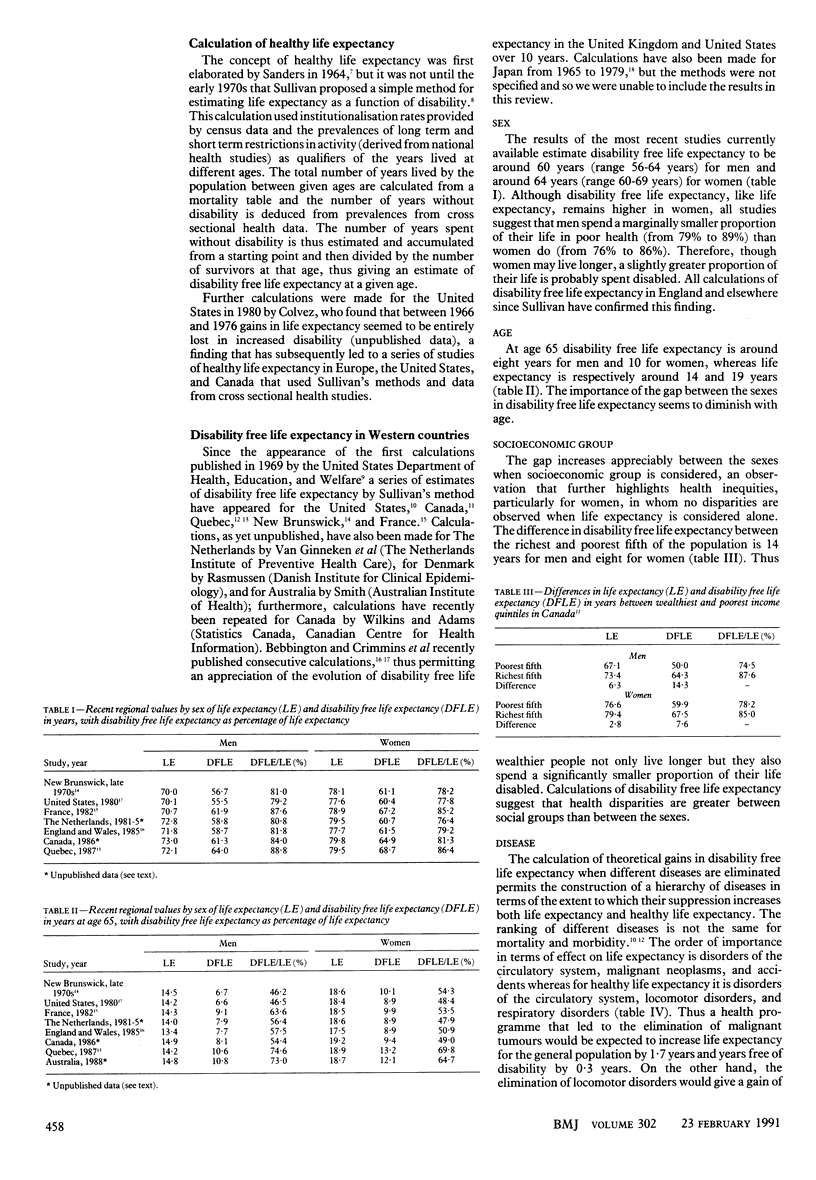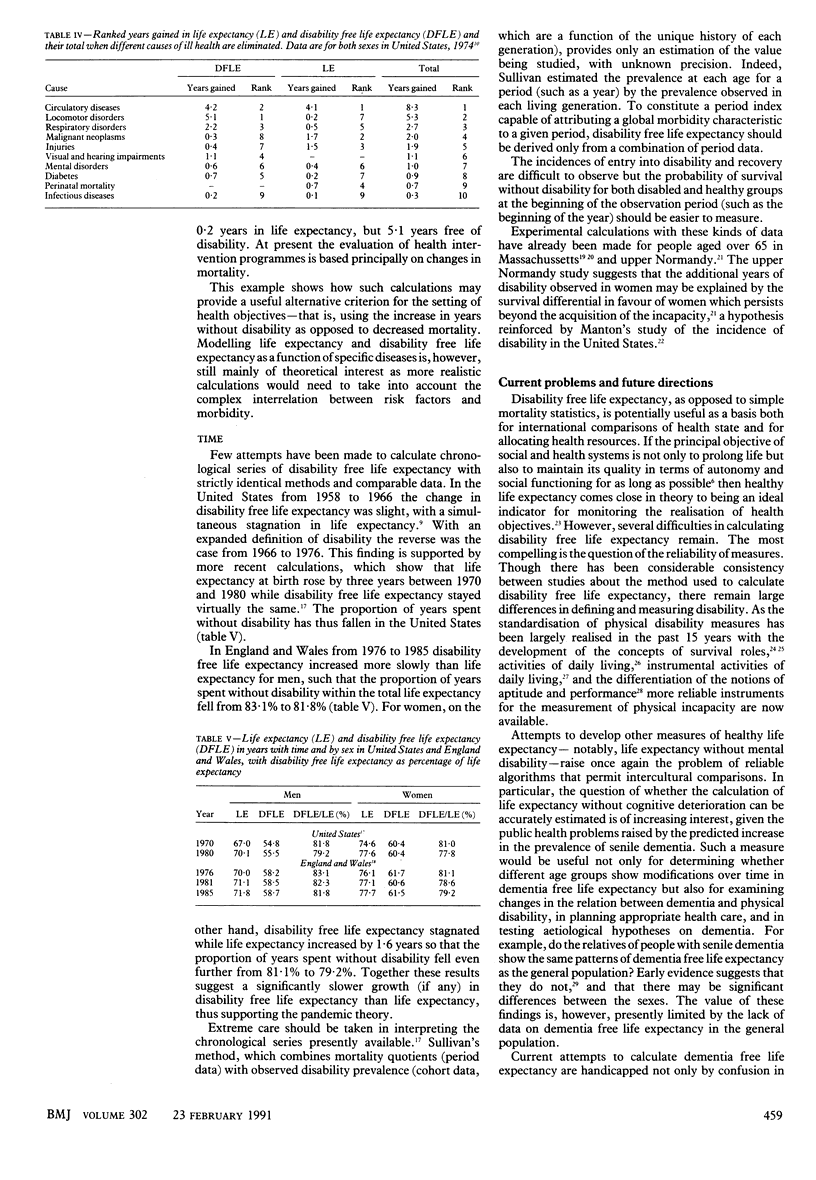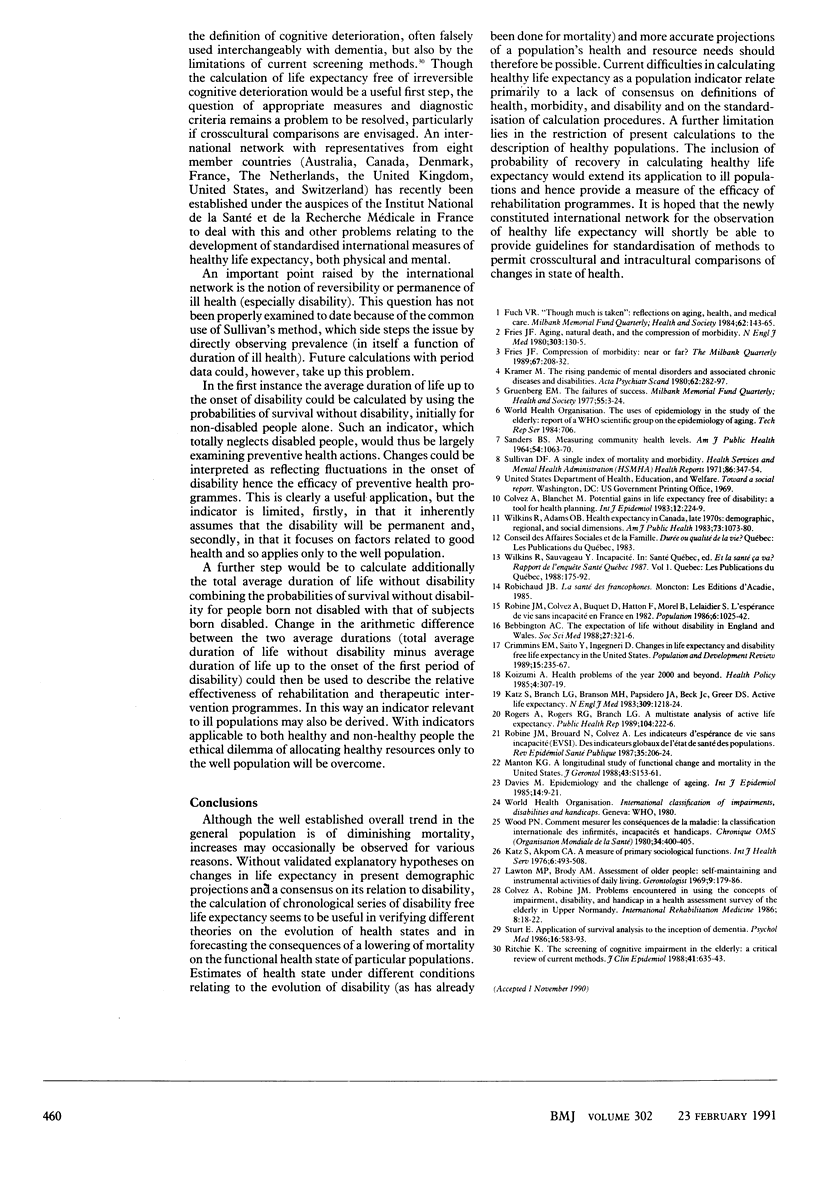Abstract
OBJECTIVE--To review and evaluate the usefulness of healthy life expectancy as a global indicator of changes in a population's health. DESIGN--Review of all known studies to date from the United States, mainland Europe, Canada, and the United Kingdom that have used Sullivan's method of calculating disability free life expectancy. MAIN OUTCOME MEASURES--Life expectancy and disability free life expectancy. RESULTS--Over the past decade the average healthy life expectancy was 60 years for men and 64 for women, with the proportion of years of disability ranging from 11% to 21% in men and from 14% to 24% in women. At the age of 65 men could expect eight years of disability free life and women 10, with the life expectancy being respectively 14 and 19 years. The difference between the wealthiest and poorest income quintiles was 6.3 years in life expectancy and 14.3 in disability free life expectancy for men and 2.8 and 7.6 respectively for women. These results suggest that disparities in health are greater between social groups than between the sexes. Diseases affect mortality and morbidity differently. The order of importance for affecting life expectancy was circulatory disease, cancer, and accidents and for disability free life expectancy, circulatory disease, locomotor disorders, and respiratory disorders. CONCLUSIONS--Healthy life expectancy is a valuable index for the appreciation of changes in both the physical and the mental health states of the general population, for allocating resources, and for measuring the success of political programmes. Future calculations should also take into account the probability of recovery and thus extend the applicability of the indicator to populations in poor health rather than focusing on the well population.
Full text
PDF



Selected References
These references are in PubMed. This may not be the complete list of references from this article.
- Bebbington A. C. The expectation of life without disability in England and Wales. Soc Sci Med. 1988;27(4):321–326. doi: 10.1016/0277-9536(88)90265-1. [DOI] [PubMed] [Google Scholar]
- Colvez A., Blanchet M. Potential gains in life expectancy free of disability: a tool for health planning. Int J Epidemiol. 1983 Jun;12(2):224–229. doi: 10.1093/ije/12.2.224. [DOI] [PubMed] [Google Scholar]
- Colvez A., Robine J. M. Problems encountered in using the concepts of impairment, disability, and handicap in a health assessment survey of the elderly in Upper Normandy. Int Rehabil Med. 1986;8(1):18–22. doi: 10.3109/03790798609166505. [DOI] [PubMed] [Google Scholar]
- Davies A. M. Epidemiology and the challenge of ageing. Int J Epidemiol. 1985 Mar;14(1):9–21. doi: 10.1093/ije/14.1.9. [DOI] [PubMed] [Google Scholar]
- Fries J. F. Aging, natural death, and the compression of morbidity. N Engl J Med. 1980 Jul 17;303(3):130–135. doi: 10.1056/NEJM198007173030304. [DOI] [PubMed] [Google Scholar]
- Fries J. F. The compression of morbidity: near or far? Milbank Q. 1989;67(2):208–232. [PubMed] [Google Scholar]
- Fuchs V. R. "Though much is taken": reflections on aging, health, and medical care. Milbank Mem Fund Q Health Soc. 1984 Spring;62(2):143–166. [PubMed] [Google Scholar]
- Gruenberg E. M. The failures of success. Milbank Mem Fund Q Health Soc. 1977 Winter;55(1):3–24. [PubMed] [Google Scholar]
- Katz S., Akpom C. A. A measure of primary sociobiological functions. Int J Health Serv. 1976;6(3):493–508. doi: 10.2190/UURL-2RYU-WRYD-EY3K. [DOI] [PubMed] [Google Scholar]
- Katz S., Branch L. G., Branson M. H., Papsidero J. A., Beck J. C., Greer D. S. Active life expectancy. N Engl J Med. 1983 Nov 17;309(20):1218–1224. doi: 10.1056/NEJM198311173092005. [DOI] [PubMed] [Google Scholar]
- Koizumi A. Health problems of the year 2000 and beyond. Health Policy. 1985;4(4):307–319. doi: 10.1016/0168-8510(85)90012-0. [DOI] [PubMed] [Google Scholar]
- Lawton M. P., Brody E. M. Assessment of older people: self-maintaining and instrumental activities of daily living. Gerontologist. 1969 Autumn;9(3):179–186. [PubMed] [Google Scholar]
- Manton K. G. A longitudinal study of functional change and mortality in the United States. J Gerontol. 1988 Sep;43(5):S153–S161. doi: 10.1093/geronj/43.5.s153. [DOI] [PubMed] [Google Scholar]
- Ritchie K. The screening of cognitive impairment in the elderly: a critical review of current methods. J Clin Epidemiol. 1988;41(7):635–643. doi: 10.1016/0895-4356(88)90115-1. [DOI] [PubMed] [Google Scholar]
- Robine J. M., Brouard N., Colvez A. Les indicateurs d'espérance de vie sans incapacité (EVSI). Des indicateurs globaux de l'état de santé des populations. Rev Epidemiol Sante Publique. 1987;35(3-4):206–224. [PubMed] [Google Scholar]
- Rogers A., Rogers R. G., Branch L. G. A multistate analysis of active life expectancy. Public Health Rep. 1989 May-Jun;104(3):222–226. [PMC free article] [PubMed] [Google Scholar]
- SANDERS B. S. MEASURING COMMUNITY HEALTH LEVELS. Am J Public Health Nations Health. 1964 Jul;54:1063–1070. doi: 10.2105/ajph.54.7.1063. [DOI] [PMC free article] [PubMed] [Google Scholar]
- Sturt E. Application of survival analysis to the inception of dementia. Psychol Med. 1986 Aug;16(3):583–593. doi: 10.1017/s0033291700010345. [DOI] [PubMed] [Google Scholar]
- Sullivan D. F. A single index of mortality and morbidity. HSMHA Health Rep. 1971 Apr;86(4):347–354. [PMC free article] [PubMed] [Google Scholar]
- Wilkins R., Adams O. B. Health expectancy in Canada, late 1970s: demographic, regional, and social dimensions. Am J Public Health. 1983 Sep;73(9):1073–1080. doi: 10.2105/ajph.73.9.1073. [DOI] [PMC free article] [PubMed] [Google Scholar]


